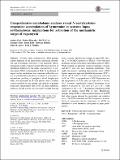| dc.contributor.author | Perl, Andras | en_US |
| dc.contributor.author | Hanczko, Robert | en_US |
| dc.contributor.author | Lai, Zhi-Wei | en_US |
| dc.contributor.author | Oaks, Zachary | en_US |
| dc.contributor.author | Kelly, Ryan | en_US |
| dc.contributor.author | Borsuk, Rebecca | en_US |
| dc.contributor.author | Asara, John M. | en_US |
| dc.contributor.author | Phillips, Paul E. | en_US |
| dc.date.accessioned | 2015-10-01T14:57:33Z | |
| dc.date.issued | 2015 | en_US |
| dc.identifier.citation | Perl, Andras, Robert Hanczko, Zhi-Wei Lai, Zachary Oaks, Ryan Kelly, Rebecca Borsuk, John M. Asara, and Paul E. Phillips. 2015. “Comprehensive metabolome analyses reveal N-acetylcysteine-responsive accumulation of kynurenine in systemic lupus erythematosus: implications for activation of the mechanistic target of rapamycin.” Metabolomics 11 (5): 1157-1174. doi:10.1007/s11306-015-0772-0. http://dx.doi.org/10.1007/s11306-015-0772-0. | en |
| dc.identifier.issn | 1573-3882 | en |
| dc.identifier.uri | http://nrs.harvard.edu/urn-3:HUL.InstRepos:22857039 | |
| dc.description.abstract | Systemic lupus erythematosus (SLE) patients exhibit depletion of the intracellular antioxidant glutathione and downstream activation of the metabolic sensor, mechanistic target of rapamycin (mTOR). Since reversal of glutathione depletion by the amino acid precursor, N-acetylcysteine (NAC), is therapeutic in SLE, its mechanism of impact on the metabolome was examined within the context of a double-blind placebo-controlled trial. Quantitative metabolome profiling of peripheral blood lymphocytes (PBL) was performed in 36 SLE patients and 42 healthy controls matched for age, gender, and ethnicity of patients using mass spectrometry that covers all major metabolic pathways. mTOR activity was assessed by western blot and flow cytometry. Metabolome changes in lupus PBL affected 27 of 80 KEGG pathways at FDR p < 0.05 with most prominent impact on the pentose phosphate pathway (PPP). While cysteine was depleted, cystine, kynurenine, cytosine, and dCTP were the most increased metabolites. Area under the receiver operating characteristic curve (AUC) logistic regression approach identified kynurenine (AUC = 0.859), dCTP (AUC = 0.762), and methionine sulfoxide (AUC = 0.708), as top predictors of SLE. Kynurenine was the top predictor of NAC effect in SLE (AUC = 0.851). NAC treatment significantly reduced kynurenine levels relative to placebo in vivo (raw p = 2.8 × 10−7, FDR corrected p = 6.6 × 10−5). Kynurenine stimulated mTOR activity in healthy control PBL in vitro. Metabolome changes in lupus PBL reveal a dominant impact on the PPP that reflect greater demand for nucleotides and oxidative stress. The PPP-connected and NAC-responsive accumulation of kynurenine and its stimulation of mTOR are identified as novel metabolic checkpoints in lupus pathogenesis. Electronic supplementary material The online version of this article (doi:10.1007/s11306-015-0772-0) contains supplementary material, which is available to authorized users. | en |
| dc.language.iso | en_US | en |
| dc.publisher | Springer US | en |
| dc.relation.isversionof | doi:10.1007/s11306-015-0772-0 | en |
| dc.relation.hasversion | http://www.ncbi.nlm.nih.gov/pmc/articles/PMC4559110/pdf/ | en |
| dash.license | LAA | en_US |
| dc.subject | Pentose phosphate pathway | en |
| dc.subject | Oxidative stress | en |
| dc.subject | Kynurenine | en |
| dc.subject | mTOR | en |
| dc.title | Comprehensive metabolome analyses reveal N-acetylcysteine-responsive accumulation of kynurenine in systemic lupus erythematosus: implications for activation of the mechanistic target of rapamycin | en |
| dc.type | Journal Article | en_US |
| dc.description.version | Version of Record | en |
| dc.relation.journal | Metabolomics | en |
| dash.depositing.author | Asara, John M. | en_US |
| dc.date.available | 2015-10-01T14:57:33Z | |
| dc.identifier.doi | 10.1007/s11306-015-0772-0 | * |
| dash.contributor.affiliated | Asara, John | |


